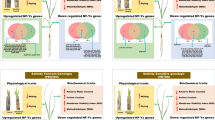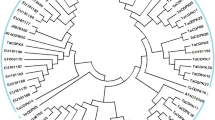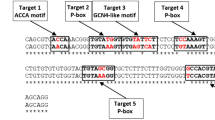Abstract
Pearl millet is a C4 cereal crop that grows in arid and semi-arid climatic conditions with the remarkable abiotic stress tolerance. It contributed to the understanding of stress tolerance not only at the physiological level but also at the genetic level. In the present study, we functionally cloned and characterized three abiotic stress-inducible promoters namely cytoplasmic Apx1 (Ascorbate peroxidase), Dhn (Dehydrin), and Hsc70 (Heat shock cognate) from pearl millet. Sequence analysis revealed that all three promoters have several cis-acting elements specific for temporal and spatial expression. PgApx pro, PgDhn pro and PgHsc70 pro were fused with uidA gene in Gateway-based plant transformation pMDC164 vector and transferred into tobacco through leaf-disc method. While PgApx pro and PgDhn pro were active in seedling stages, PgHsc70 pro was active in stem and root tissues of the T2 transgenic tobacco plants under control conditions. Higher activity was observed under high temperature and drought, and less in salt and cold stress conditions. Further, all three promoters displayed higher GUS gene expression in the stem, moderate expression in roots, and less expression in leaves under similar conditions. While RT-qPCR data showed that PgApx pro and PgDhn pro were expressed highly in high temperature, salt and drought, PgHsc70 pro was fairly expressed during high temperature stress only. Histochemical and RT-qPCR assays showed that all three promoters are inducible under abiotic stress conditions. Thus, these promoters appear to be immediate candidates for developing abiotic stress tolerant crops as these promoter-driven transgenics confer high degree of tolerance in comparison with the wild-type (WT) plants.





Similar content being viewed by others
Abbreviations
- Pg:
-
Pennisitum glaucum
- Apx:
-
Ascorbate peroxidase
- Dhn:
-
Dehydrin
- Hsc70:
-
Heat shock cognate 70
- GE:
-
Genetic engineering
- SOD:
-
Superoxide dismutase
- BAP:
-
6-benzylaminopurine
- NAA:
-
Napthaleneacetic acid
- GUS:
-
ß-glucuronidase
- MS:
-
Murashige and Skoog
References
Grayson M (2013) Agriculture and drought. Nature 501:S1. https://doi.org/10.1038/501S1a
Christensen JH, Christensen OB (2007) A summary of the PRUDENCE model projections of changes in European climate by the end of this century. Clim Chang 81:7–30
Cramer GR, Urano K, Delrot S, Pezzotti M, Shinozaki K (2011) Effects of abiotic stress on plants: a systems biology perspective. BMC Plant Biol 11:163
Krasensky J, Jonak C (2012) Drought, salt, and temperature stress-induced metabolic rearrangements and regulatory networks. J Exp Bot 63:1593–1608
Mishra RN, Reddy PS, Nair S, Markandeya G, Reddy AR, Sopory SK, Reddy MK (2007) Isolation and characterization of expressed sequence tags (ESTs) from subtracted cDNA libraries of Pennisetum glaucum seedlings. Plant Mol Biol 64:713–732
Yamaguchi-Shinozaki K, Shinozaki K (2006) Transcriptional regulatory networks in cellular responses and tolerance to dehydration and cold stresses. Annu Rev Plant Biol 57:781–803
Morozova O, Marra MA (2008) Applications of next-generation sequencing technologies in functional genomics. Genomics 92:255–264
Schuster SC (2007) Next-generation sequencing transforms today’s biology. Nat Methods 5:16
Hirt H, Shinozaki K (2003) Plant responses to abiotic stress. Springer Science, Berlin
Apel K, Hirt H (2004) Reactive oxygen species: metabolism, oxidative stress, and signal transduction. Annu Rev Plant Biol 55:373–399
Bihmidine S, Lin J, Stone JM, Awada T, Specht JE, Clemente TE (2013) Activity of the Arabidopsis RD29A and RD29B promoter elements in soybean under water stress. Planta 237:55–64
Mur LA, Sturgess FJ, Farrell GG, Draper J (2004) The AoPR10 promoter and certain endogenous PR10 genes respond to oxidative signals in Arabidopsis. Mol Plant Pathol 5:435–451
Srivastava VK, Raikwar S, Tuteja N (2014) Cloning and functional characterization of the promoter of PsSEOF1 gene from Pisum sativum under different stress conditions using Agrobacterium-mediated transient assay. Plant Signal Behav 9(9):e29626
Rerksiri W, Zhang X, Xiong H, Chen X (2013) Expression and promoter analysis of six heat stress-inducible genes in rice. Sci W J. https://doi.org/10.1155/2013/397401
Chakravarthi M, Syamaladevi DP, Harunipriya P, Augustine SM, Subramonian N (2016) A novel PR10 promoter from Erianthus arundinaceus directs high constitutive transgene expression and is enhanced upon wounding in heterologous plant systems. Mol Biol Rep 43:17–30
Hou J, Jiang P, Qi S, Zhang K, He Q, Xu C, Li K (2016) Isolation and functional validation of salinity and osmotic stress inducible promoter from the maize type-II H + - pyrophosphatase gene by deletion analysis in transgenic tobacco plants. PLoS ONE 11:e0154041
Bhuria M, Goel P, Kumar S, Singh AK (2016) The promoter of AtUSP is co-regulated by phytohormones and abiotic stresses in Arabidopsis thaliana. Front Plant Sci 7:1957
Pellegrineschi A, Reynolds M, Pacheco M, Brito RM, Almeraya R, Yamaguchi- Shinozaki K, Hoisington D (2004) Stress-induced expression in wheat of the Arabidopsis thaliana DREB1A gene delays water stress symptoms under greenhouse conditions. Genome 47:493–500
Nakashima K, Tran LSP, Van Nguyen D, Fujita M, Maruyama K, Todaka D, Yamaguchi- Shinozaki K (2007) Functional analysis of a NAC type transcription factor OsNAC6 involved in abiotic and biotic stress responsive gene expression in rice. Plant J 51:617–630
Li F, Han Y, Feng Y, Xing S, Zhao M, Chen Y, Wang W (2013) Expression of wheat expansin driven by the RD29 promoter in tobacco confers water-stress tolerance without impacting growth and development. J Biotechnol 163:281–291
Shafi A, Pal AK, Sharma V, Kalia S, Kumar S, Ahuja PS, Singh AK (2017) Transgenic potato plants overexpressing SOD and APX exhibit enhanced lignification and starch biosynthesis with improved salt stress tolerance. Plant Mol Biol Rep 35:504–518
Wang Y, Wisniewski M, Meilan R, Cui M, Webb R, Fuchigami L (2005) Overexpression of cytosolic ascorbate peroxidase in tomato confers tolerance to chilling and salt stress. J Am Soc Hortic Sci 130:167–173
Wang Y, Wisniewski M, Meilan R, Cui M, Fuchigami L (2006) Transgenic tomato (Lycopersicon esculentum) overexpressing cAPX exhibits enhanced tolerance to UV-B and heat stress. J Appl Hort 8:87–90
Yabuta Y, Motoki T, Yoshimura K, Takeda T, Ishikawa T, Shigeoka S (2002) Thylakoid membrane-bound ascorbate peroxidase is a limiting factor of antioxidative systems under photo-oxidative stress. Plant J 32:915–925
Sato Y, Masuta Y, Saito K, Murayama S, Ozawa K (2011) Enhanced chilling tolerance at the booting stage in rice by transgenic overexpression of the ascorbate peroxidase gene, OsAPXa. Plant Cell Rep 30:399–406
Ishikawa T, Morimoto Y, Madhusudhan R, Sawa Y, Shibata H, Yabuta Y, Shigeoka S (2005) Acclimation to diverse environmental stresses caused by a suppression of cytosolic ascorbate peroxidase in tobacco BY-2 cells. Plant Cell Physiol 46:1264–1271
Sun WH, Duan M, Li F, Shu DF, Yang S, Meng QW (2010) Overexpression of tomato tAPX gene in tobacco improves tolerance to high or low temperature stress. Biol Plant 54:614–620
Graether SP, Boddington KF (2014) Disorder and function: a review of the dehydrin protein family. Front Plant Sci 5:576
Singh J, Reddy PS, Reddy CS, Reddy MK (2015) Molecular cloning and characterization of salt inducible dehydrin gene from the C4 plant Pennisetum glaucum. Plant Gene 4:55–63
Nagaraju M, Reddy PS, Kumar SA, Kumar A, Suravajhala P, Ali A, Rao DM (2018) Genome-wide in silico analysis of dehydrins in Sorghum bicolor, Setaria italica and Zea mays and quantitative analysis of dehydrin gene expressions under abiotic stresses in Sorghum bicolor. Plant Gene 13:64–75
Peng Y, Reyes JL, Wei H, Yang Y, Karlson D, Covarrubias AA, Arora R (2008) RcDhn5, a cold acclimation-responsive dehydrin from Rhododendron catawbiense rescues enzyme activity from dehydration effects in vitro and enhances freezing tolerance in RcDhn5 overexpressing Arabidopsis plants. Physiol Plant 134:583–597
Ganguly M, Datta K, Roychoudhury A, Gayen D, Sengupta DN, Datta SK (2012) Overexpression of Rab16A gene in indica rice variety for generating enhanced salt tolerance. Plant Signal Behav 7:502–509
Cheng WH, Endo A, Zhou L, Penney J, Chen HC, Arroyo A, Koshiba T (2002) A unique short-chain dehydrogenase/reductase in Arabidopsis glucose signaling and abscisic acid biosynthesis and functions. Plant Cell 14:2723–2743
Brini F, Hanin M, Lumbreras V, Amara I, Khoudi H, Hassairi A, Masmoudi K (2007) Overexpression of wheat dehydrin DHN-5 enhances tolerance to salt and osmotic stress in Arabidopsis thaliana. Plant Cell Rep 26:2017–2026
Roy Choudhury A, Roy C, Sengupta DN (2007) Transgenic tobacco plants overexpressing the heterologous lea gene Rab16A from rice during high salt and water deficit display enhanced tolerance to salinity stress. Plant Cell Rep 26:1839–1859
Reddy PS, Mallikarjuna G, Kaul T, Chakradhar T, Mishra RN, Sopory SK, Reddy MK (2010) Molecular cloning and characterization of gene encoding for cytoplasmic Hsc70 from Pennisetum glaucum may play a protective role against abiotic stresses. Mol Genet Genomics 283:243–254
Reddy PS, Kishor PBK, Seiler C, Kuhlmann M, Eschen-Lippold L, Lee J, Sreenivasulu N (2014) Unraveling regulation of the small heat shock proteins by the heat shock factor HvHsfB2c in barley: its implications in drought stress response and seed development. PLoS ONE 9(3):e89125
Reddy PS, Sharma KK, Vadez V, Reddy MK (2015) Molecular cloning and differential expression of cytosolic class I small Hsp gene family in Pennisetum glaucum (L.). Appl Biochem Biotechnol 176:598–612
Reddy PS, Chakradhar T, Reddy RA, Nitnavare RB, Mahanty S, Reddy MK (2016) Role of heat shock proteins in improving heat stress tolerance in crop plants. Heat shock proteins and plants. Springer, Cham, pp 283–307
Nitnavare RB, Yeshvekar RK, Sharma KK, Vadez V, Reddy MK, Reddy PS (2016) Molecular cloning, characterization and expression analysis of a heat shock protein 10 (Hsp10) from Pennisetum glaucum (L.), a C4 cereal plant from the semi-arid tropics. Mol Biol Rep 43:861–870
Wang Y, Lin S, Song Q, Li K, Tao H, Huang J, He H (2014) Genome-wide identification of heat shock proteins (Hsps) and Hsp interactors in rice: Hsp70 s as a case study. BMC Genomics 15:344
Zhang XP, Glaser E (2002) Interaction of plant mitochondrial and chloroplast signal peptides with the Hsp70 molecular chaperone. Trends Plant Sci 7:14–21
Hartl FU, Hayer-Hartl M (2002) Molecular chaperones in the cytosol: from nascent chain to folded protein. Science 295:1852–1858
Mirus O (1803) Schleiff E (2009) The evolution of tetratricopeptide repeat domain containing receptors involved in protein translocation-Review. Endocytobiosis Cell Res 10:1115–1130
Yu A, Yu A, Li P, Tang T, Wang J, Chen Y, Liu L (2015) Roles of Hsp70 s in stress responses of microorganisms, plants, and animals. BioMed Res Int. https://doi.org/10.1155/2015/510319
Reddy PS, Mahanty S, Kaul T, Nair S, Sopory SK, Reddy MK (2008) A high-throughput genome-walking method and its use for cloning unknown flanking sequences. Anal Biochem 381:248–253
Lescot M, Déhais P, Thijs G, Marchal K, Moreau Y, Van de Peer Y, Rombauts S (2002) PlantCARE, a database of plant cis-acting regulatory elements and a portal to tools for in silico analysis of promoter sequences. Nucleic Acids Res 30:325–327
Chang WC, Lee TY, Huang HD, Huang HY, Pan RL (2008) PlantPAN: plant promoter analysis navigator, for identifying combinatorial cis-regulatory elements with distance constraint in plant gene groups. BMC Genomics 9:561
Horsch RB, Fry J, Hoffmann N, Neidermeyer J, Rogers SG, Fraley RT (1989) Leaf disc transformation. Plant molecular biology manual. Springer, Dordrecht, pp 63–71
Jefferson RA, Kavanagh TA, Bevan MW (1987) GUS fusions: beta-glucuronidase as a sensitive and versatile gene fusion marker in higher plants. EMBO J 6:3901–3907
Schmidt GW, Delaney SK (2010) Stable internal reference genes for normalization of real-time RT-PCR in tobacco (Nicotiana tabacum) during development and abiotic stress. Mol Genet Genomics 283:233–241
Vijayalakshmi T, Varalaxmi Y, Jainender S, Yadav SK, Vanaja M, Jyothilakshmi N, Maheswari M (2012) Physiological and biochemical basis of water-deficit stress tolerance in pearl millet hybrid and parents. Am J Plant Sci 3(12):1730
Pan J, Li Z, Wang Q, Garrell AK, Liu M, Guan Y, Liu W (2018) Comparative proteomic investigation of drought responses in foxtail millet. BMC Plant Biol 18(1):315
Hasanuzzaman M, Nahar K, Alam M, Roychowdhury R, Fujita M (2013) Physiological, biochemical, and molecular mechanisms of heat stress tolerance in plants. Int J Mol Sci 14(5):9643–9684
Reddy RA, Kumar B, Reddy PS, Mishra RN, Mahanty S, Kaul T, Reddy MK (2009) Molecular cloning and characterization of genes encoding Pennisetum glaucum ascorbate peroxidase and heat-shock factor: interlinking oxidative and heat-stress responses. J Plant Physiol 166:1646–1659
Tóth SZ, Nagy V, Puthur JT, Kovács L, Garab G (2011) The physiological role of ascorbate as photosystem II electron donor: protection against photo inactivation in heat- stressed leaves. Plant Physiol 156(1):382–392
Ortner V, Ludwig A, Riegel E, Dunzinger S, Czerny T (2015) An artificial HSE promoter for efficient and selective detection of heat shock pathway activity. Cell Stress Chaperones 20:277–288
Sato Y, Murakami T, Funatsuki H, Matsuba S, Saruyama H, Tanida M (2001) Heat shock-mediated APX gene expression and protection against chilling injury in rice seedlings. J Exp Bot 52:145–151
Yang Y, He M, Zhu Z, Li S, Xu Y, Zhang C, Wang Y (2012) Identification of the dehydrin gene family from grapevine species and analysis of their responsiveness to various forms of abiotic and biotic stress. BMC Plant Biol 12:140
Hu WH, Song XS, Shi K, Xia XJ, Zhou YH, Yu JQ (2008) Changes in electron transport, superoxide dismutase and ascorbate peroxidase isoenzymes in chloroplasts and mitochondria of cucumber leaves as influenced by chilling. Photosynthetica 46:581
Gill SS, Tuteja N (2010) Reactive oxygen species and antioxidant machinery in abiotic stress tolerance in crop plants. Plant Physiol Biochem 48:909–930
Shafi A, Dogra V, Gill T, Ahuja PS, Sreenivasulu Y (2014) Simultaneous over- expression of PaSOD and RaAPX in transgenic Arabidopsis thaliana confers cold stress tolerance through increase in vascular lignifications. PLoS ONE 9:e110302
Halder T, Upadhyaya G, Basak C, Das A, Chakraborty C, Ray S (2018) Dehydrins impart protection against oxidative stress in transgenic tobacco plants. Front Plant Sci 9:136
Lu Z, Liu D, Liu S (2007) Two rice cytosolic ascorbate peroxidases differentially improve salt tolerance in transgenic Arabidopsis. Plant Cell Rep 26:1909–1917
Wisniewski ME, Bassett CL, Renaut J, JrR Farrell, Tworkoski T, Artlip TS (2006) Differential regulation of two dehydrin genes from peach (Prunus persica) by photoperiod, low temperature and water deficit. Tree Physiol 26:575–584
Acknowledgements
PSR acknowledges the Department of Science and Technology, New Delhi, Government of India for the research grant and award through INSPIRE Faculty (Award No. IFA11-LSPA-06). This work was undertaken as part of the CGIAR Research Program on GLDC.
Author information
Authors and Affiliations
Contributions
PSR and VV designed the experiments, KD, PSR, PBM and PS executed the study, PSR, KD and PBK analyzed data. PSR, KKS, PBK and KD wrote the manuscript.
Corresponding author
Ethics declarations
Conflict of interest
The authors declare that the research was conducted in the absence of any commercial or financial relationships that could be construed as a potential conflict of interest.
Additional information
Publisher's Note
Springer Nature remains neutral with regard to jurisdictional claims in published maps and institutional affiliations.
Electronic supplementary material
Below is the link to the electronic supplementary material.
Rights and permissions
About this article
Cite this article
Divya, K., Kavi Kishor, P.B., Bhatnagar-Mathur, P. et al. Isolation and functional characterization of three abiotic stress-inducible (Apx, Dhn and Hsc70) promoters from pearl millet (Pennisetum glaucum L.). Mol Biol Rep 46, 6039–6052 (2019). https://doi.org/10.1007/s11033-019-05039-4
Received:
Accepted:
Published:
Issue Date:
DOI: https://doi.org/10.1007/s11033-019-05039-4




